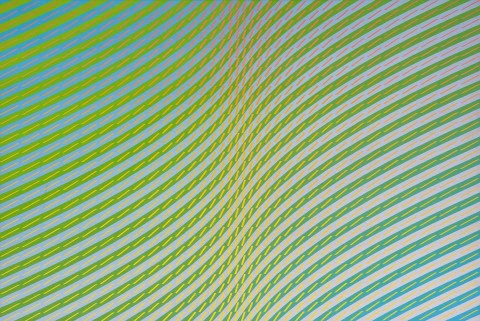CHINOOK, 1975
LESLEY DUMBRELL
synthetic polymer paint on canvas
175.0 x 260.0 cm
signed and dated verso: L. Dumbrell 75.
bears inscription on stretcher bar verso: CHINOOK
Abraxas Gallery, Canberra
Tolarno Galleries, Melbourne
The National Australia Bank Art Collection, acquired from the above in 1977 (label attached verso)
Lesley Dumbrell: Paintings and Studies, Abraxas Gallery, Canberra, 16 March - 4 April 1976, cat. 4
The Seventies: Australian Paintings and Tapestries from the Collection of National Australia Bank, National Gallery of Victoria, Melbourne, 15 October – 28 November 1982
Good vibrations: the legacy of Op Art in Australia, Heide Museum of Modern Art, Melbourne, 7 October – 24 November 2002
de Groen, G., ‘Real Sensitivity Shown’, The Canberra Times, Canberra, 23 March 1976, p. 11
Lindsay, R., The Seventies: Australian Paintings and Tapestries from the
Collection of National Australia Bank, The National Bank of Australasia, Melbourne, 1982, pl. 33, p. 46 (illus.), front cover (illus.)
Hart, D., William Delafield Cook, Craftsman House, Sydney, 1998, p. 119
Stanhope, Z., Good vibrations: the legacy of Op Art in Australia, Heide Museum of Modern Art, Melbourne, 2002, p. 26 (illus.)
'Good vibrations to test the retina', The Age, Melbourne, 16 November 2002
Foehn, 1975, synthetic polymer paint on canvas, 247.3 x 199.8 cm, in the collection of the National Gallery of Australia, Canberra
Zephyr, 1975, acrylic on linen, dimensions and location unknown (illus. on Leslie Dumbrell Portfolio. Optical Paintings, https://www.lesleydumbrell.com/portfolio/optical-paintings-1970s)
Chinook, 1975 is from a time when many Australian artists were flitting between styles with some settling to produce paintings quite unlike earlier but, nevertheless, recent work. During the next decade there was considerable institutional reflection and speculation about the various appearances of abstraction and figuration. These took the form of exhibitions and critical writing: none included Australianness or a vernacular slant to give local meaning to art which was international in character.1 In Lesley Dumbrell’s home city, Melbourne, aspects of the much-vaunted The Field exhibition continued to echo while a variety of other responses were open to new and recent trends. With the rise of Postmodernist theory, we were numbed by its claims of the end of Modernism.
Dumbrell was untroubled by any need to accommodate or respond to such fractious debates. Her path was set early. Colourfield formalism and lyrical abstraction painting had been overwhelmingly the dominion of men. Abundant with possibilities, her subtly evolving abstraction would distinguish her career. An early interest in Mondrian and Malevich emphasised the resoluteness of abstraction, while Kandinsky’s colour theories of ‘inner resonance’ and a colour’s need to evoke feeling, were clearly complementary to Dumbrell’s own instincts. Modernism was her wellspring and her encounter with the work of Bridget Riley and Jesús Rafael Soto was telling.2
Feminist activism was flourishing in Melbourne and Dumbrell was involved in various projects and surrounded by like-minded women. This found expression in a variety of ways including the exhibition, A Room of One’s Own in 1975. During the that year, she also became a founding member of the Women’s Art Register.3
‘The reconciliation of feminism and the new abstract art… was for Dumbrell a vexed issue. Patterning and decoration, which were traditionally associated with women’s art forms, nonetheless found a voice in abstraction.’4 Her work is obviously disconnected from doctrinaire abstract formalists whose pursuit of Greenberg-espoused ‘purity’ rejected externally observed or felt influences intruding into the idea of a standalone and independent painting being self-referential and about itself, nothing else.
Chinook shimmers with light and the shapes oscillate with a gently orchestrated palette. It is underpinned by a discreet system and patterned logic, and while its debt to Op art is self-evident, here she reaches a complete resolution of a distinctly personal pictorial vocabulary. It is an intensely visual and sensory painting whose title reminds us of the reach of her inspiration; ‘Chinook’ is a warm prevailing wind in western North America.
1. Australian art 1960 – 1986, Field to Figuration, Works from the National Gallery of Victoria, National Gallery of Victoria, Melbourne, 1986; Vox Pop, Into the Eighties, National Gallery of Victoria, Melbourne, 1983; POPISM, National Gallery of Victoria, Melbourne, 1982; Geometric Abstraction, Australian Centre for Contemporary Art, Melbourne, 1986.
2. Bridget Riley (born 1931) and Victor Vasarely (1908 – 1997) were British exponents of Op art, while Jesús Rafael Soto (1923 – 2005) Venezuelan op and kinetic artist.
3. A Room of One’s Own, Ewing & George Paton Galleries, The University of Melbourne, Melbourne, 1975
4. Kent, R., Shades of Light: Lesley Dumbrell 1971 – 1999, Ian Potter Museum of Art, the University of Melbourne, 1999
DOUG HALL AM
